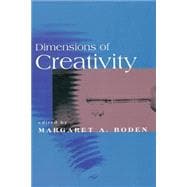
Note: Supplemental materials are not guaranteed with Rental or Used book purchases.
Purchase Benefits
Looking to rent a book? Rent Dimensions of Creativity [ISBN: 9780262522199] for the semester, quarter, and short term or search our site for other textbooks by Boden, Margaret A.. Renting a textbook can save you up to 90% from the cost of buying.
| Contributors | |
| Acknowledgments | |
| Introduction | |
| Making Up Discovery | |
| Perspiration and Inspiration | |
| The Man on the Clapham Omnibus | |
| In Search of the Source | |
| The Ends of Discovery | |
| Acknowledgments | |
| References | |
| Where Do New Ideas Come From? | |
| Probabilistic Functionalism | |
| New Tools: The Inference Revolution | |
| New Ideas: The Cognitive Revolution | |
| Causal Reasoning: Mind as Statistician | |
| Practical Context versus Mathematical Structure | |
| Sensory Detection and Discrimination: Mind as Statistician | |
| The Mind as Intuitive Statistician | |
| Conclusions | |
| Institutionalized Rituals of Scientific Justification | |
| From Institutionalzed Tools to Compelling Theories | |
| Which Comes First, Discovery or Justification? | |
| References | |
| What Is Creativity? | |
| The Definition of Creativity | |
| Exploring and Transforming Conceptual Spaces | |
| The Relevance of Computational Psychology | |
| Conceptual Spaces in the Visual Arts | |
| Modeling Musical Creativity | |
| Literary Spaces | |
| Analogy | |
| Transformation in Models of Scientific Discovery | |
| Genetic Algorithms | |
| Can Creativity Be Measured? | |
| References | |
| Creativity: Beyond the Darwinian Paradigm | |
| Adaptive Novelty and Klondike Spaces | |
| The Evolutionary Creative System | |
| The Meme Creative System | |
| The Inventor Creative System | |
| Can We Measure Creativity? | |
| The Evolution of Invention | |
| Acknowledgment | |
| References | |
| The Creators' Patterns | |
| Approaches to Creativity | |
| The Present Approach | |
| E. C.: An Exemplary Creator | |
| Cognition | |
| Other Psychological Dimensions | |
| Domain | |
| Field | |
| Fruitful Asynchrony | |
| Two Unexpected Findings | |
| Final Reflections | |
| Note | |
| References | |
| How Can We Measure a Society's Creativity? | |
| A Psychological Theory of Aesthetic Evolution | |
| Aesthetic Variability | |
| Selection Criteria | |
| Hedonic Selection | |
| The Direction of Aesthetic Evolution | |
| General Predictions | |
| Strong and Weak Versions of the Theory | |
| Retention Mechanisms | |
| The Timing of Stylistic Change | |
| Empirical Investigations | |
| The Evolution of British Poetry | |
| Sampling | |
| General Method | |
| Programs | |
| Arousal Potential | |
| Primordial Content | |
| Stylistic Change | |
| Tests of the Strong versus Weak Versions of the Theory | |
| Specificity of the Trends to Poetic Language | |
| Conclusions | |
| Sociocultural Correlates of Creativity in Great Britain | |
| References | |
| The Measurement of Creativity | |
| The Definition of Creativity | |
| Creativity as a Trait | |
| Creativity as Achievement | |
| The Creative Personality | |
| The Creative Personality and Preference for Complexity | |
| Psychoticism and Creativity | |
| Psychoticism and the Creative Process | |
| Discussion and Summary | |
| References | |
| Index | |
| Table of Contents provided by Publisher. All Rights Reserved. |
The New copy of this book will include any supplemental materials advertised. Please check the title of the book to determine if it should include any access cards, study guides, lab manuals, CDs, etc.
The Used, Rental and eBook copies of this book are not guaranteed to include any supplemental materials. Typically, only the book itself is included. This is true even if the title states it includes any access cards, study guides, lab manuals, CDs, etc.